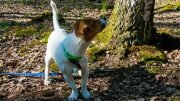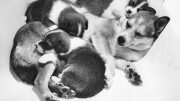The Norwegian Hound, also known as the Dunker, is one of the seven Norwegian native dog breed varieties, a scent hound with outstanding hunting qualities. The mottled color and glass eyes make it quite distinguished and different from other hare hounds.
According to the Norwegian Kennel Club and the Swedish Kennel Club, the history of the Norwegian “Dunker” Hounds started in the 1800s. The dogs were named after Captain Wilhelm Conrad Dunker, who crossed several scent hounds while living in the southern parts of Norway.
In 1826, Wilhelm Dunker’s first hound was an offspring of a grey-marbled female and an almost completely white male, of unknown origin.
In 1877, the first dog show for the Nordic countries was organized in Oslo by Christiania Jægerklub; an exhibit arranged specially for hunting dog breeds with an aim of safeguarding the Norwegian breed types. In 1895, the first standard for Norwegian hare and fox hounds was issued.
In 1902, the Norwegian “Dunker” Hound was recognized as its own breed. The dogs were sought-after all over the country, and approximately 700 puppies would be registered yearly at the time. The Special Club for Norwegian Hare Hounds was founded in the same year.
The objective was supposed to be primarily for the systematic breeding of the Dunker. However, the decision was made to divide the hare hounds into two main groups, the Norwegian “Dunker” Hound and the Hygen Hound.
In 1925, the Norwegian “Dunker” Hound and Hygen Hound were combined and classified as the Norwegian harehound. Eventually, the breeds were separated again in 1934.
During World War II, the low demand for the Dunker led to difficulty in maintaining systematic breeding of high quality. After the war, an astounding improvement in the interest for the hounds ensued.
The popularity of the Norwegian “Dunker” Hounds continued up to the 1970s when the Finish harehounds became popular due to their better attributes.
In 1987, because of concerns related to the narrow breeding base and the dogs being too closely related, the Norwegian “Dunker” Hound committee requested approval from the Norwegian Kennel Club to pair the dog with other breeds. The request was initially rejected and was only authorized two years later. Following the decision, the Dunker has been healthier with more genetic variation, while retaining its typical and well-defined traits.
Since 2006, puppies have been exported to Greece, Cyprus, and Italy, but Norway retains the biggest number of Dunker hounds.
Although nowadays the Norwegian “Dunker” Hounds are a healthy breed, the population is small, and fewer than 200 puppies are registered yearly, with an estimate of between 131 and 180 puppies per year in the last decade.
The Norwegian Hound: Standards
According to the standard descriptions, the Norwegian Hound appears to be rectangular, medium-sized, with a strong and powerful build, and impressive endurance.
Males are normally 50–58 cm in height, 52–54 cm being ideal. Females are normally 47–54 cm in height, 49–51 cm being ideal.
Their head is never wedge-shaped. Their coat is straight, hard, dense, and not very short; usually of a diluted black color with tan markings or blue marbled “merle” color with pale tan and white markings.
These hounds originally had a broad breeding base and heterogeneous characteristics.
Presently, they are noticed for their particularly well-knit paws which can dig through ice and crusty snow much better than paws of other scent hounds. They have wide tapered ears dangling flat without folds, thick tapered tails reaching slightly below the hock, fairly long necks, and large and round dark eyes. Although blue-marbled hounds can be wall-eyed or have eyes of different colors.
According to the book “Illustrated Guide to Dog Breeds” by Joan Palmer, the Norwegian Hound has considerable trekking abilities and is a good retriever used for hunting hares.
Furthermore, the hounds cooperate well and can proceed at close range side by side with their owners out in the woods. It is also advisable for owners to ensure that the dogs receive adequate physical and mental stimulation.
The Norwegian Hounds are praised for being affectionate, trainable, hardy, and robust with their open nature, excellent temperament, and particularly being trustful and sociable.
Moreover, according to the strategy report by the Norwegian Harehound Clubs Association, the dogs are perceived as pleasant and unproblematic to live with, without any significant behavioral problems despite some occurrences with intolerance of the same gender.
Their genetic variation seems to be faring well. They are in good health and well-suited working dogs. Incidence of some health problems includes hip dysplasia, epilepsy, or EP-like seizures, hypothyroidism, low metabolism, heart failure, epiphyseal dysplasia, hair follicle mite, furunculosis, and allergies. Occurrences of reproductive problems are related to low fertility in males and females.
These hounds do not require extensive grooming.
Source: #Norway Today / #NorwayTodayTravel
Do you have a news tip for Norway Today? We want to hear it. Get in touch at [email protected]



Be the first to comment on "What you need to know about the Norwegian Hound – the famous Dunker"